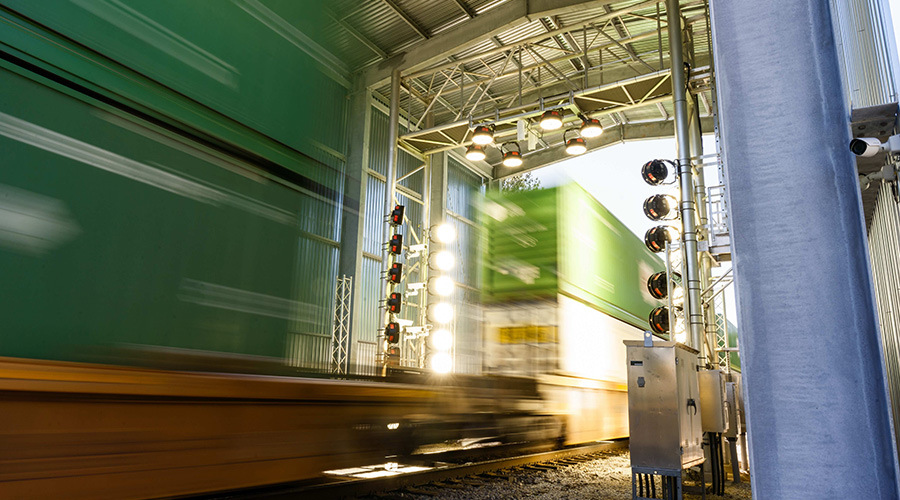Alaska Railroad, DOT test UAS-based avalanche mitigation technology
3/15/2024
By Julie Sneider, Senior Editor
Alaska Railroad Corp. (ARRC) and the Alaska Department of Transportation and Public Facilities (AKDOT) are collaborating on a pioneering project that uses unmanned aircraft systems (UAS) to advance avalanche mitigation technology.
In January, AKDOT and the railroad successfully deployed and detonated two explosives using Drone Amplified’s Drone Avalanche Reduction Technology (DART) to trigger two manmade snow slides. Drone Amplified is a U.S.-based UAS company that specializes in drone-based land management solutions. AKDOT and ARRC’s test of the DART system was conducted as part of a project to determine how drones can be used to safely and efficiently reduce the risk of avalanches.
Snow avalanches in Alaska regularly damage or destroy infrastructure and block transportation corridors, impeding access to natural resources and critical public services, according to the Alaska Department of Natural Resources. About 30% of the state is affected by avalanches. They cannot be prevented in all avalanche paths that affect the highway, but the encounter risk can be reduced, state officials say.
To help forecast avalanche hazards and the necessity for temporary vehicle and rail traffic delays for avalanche work, AKDOT and ARRC regularly monitor weather, terrain and snowpack conditions. When conditions are right, specially trained maintenance crews use military artillery and other methods to artificially trigger avalanches.
AKDOT and ARRC each have their own avalanche mitigation programs. AKDOT’s annual avalanche season — which lasts longer than the railroad’s because the state’s territory stretches into arctic areas — typically runs from September through May and sometimes as late as June. The railroad’s season generally runs from October into May.
AKDOT has been studying UAS for the past couple of years, according to Timothy Glassett, AKDOT’s avalanche and artillery program manager. Working with ARRC, the department tested the DART system with explosives as part of avalanche mitigation for the first time in January; due to that test's success, more tests will be conducted this year. Developing and deploying a drone-based DART system requires meeting significant regulatory requirements, especially those of the Federal Aviation Administration (FAA).
The department and railroad had to get the FAA’s authorization to deploy explosives and/or hazmat materials via UAS. Other entities, including the U.S. Forest Service and explosives manufacturer CIL, also had to give the green light before testing could begin. All told, it took an entire avalanche season to align all the necessary approvals.
The successful DART system test builds on a foundation of prior technological efforts to demonstrate the feasibility of using a heavy lift UAS platform to drop an explosive round for avalanche control, say Glassett and ARRC Avalanche Program Manager Matt McKee.
Alaska Railroad got involved in the DART testing project by finding a spot on the rail network where a trial run could be conducted safely. The chosen site was at least 15 miles from roads, highways and other public infrastructure; the closest city to the test site was Whittier, Alaska.
 The AltaX Drone with the DART attachment is shown dropping an inert round in a test conducted for the Alaska DOT and Alaska Railroad’s avalanche mitigation programs. Drone Amplified/Alaska Railroad Corp./Alaska DOT
The AltaX Drone with the DART attachment is shown dropping an inert round in a test conducted for the Alaska DOT and Alaska Railroad’s avalanche mitigation programs. Drone Amplified/Alaska Railroad Corp./Alaska DOT“The railroad’s terrain was ideal for the testing because we could use our hi-rails to get out there relatively quickly and where nobody else could access the area,” McKee says.
Avalanche hazards on rail
The chances of an avalanche hitting a moving train are pretty low, McKee says. The greater concern is that debris from an avalanche will land on the track, blocking a train’s path. In high-risk areas, the railroad has designated avalanche “slide zones” in which trains are required to slow down to 15 mph.
“There’s a high likelihood of a train running into a downed avalanche, which is our biggest concern,” says McKee. “We had a derailment last year when a train hit a downed avalanche. So, that’s our biggest problem and we have a number of ways to mitigate that.”
The UAS-based technology undergoing testing now represents “a significant step forward in risk reduction for our public highways,” says Glassett. Both the state and the railroad are moving away from using military artillery — such as howitzers — as a primary form of avalanche mitigation.
In place of artillery, the state is adopting remote avalanche control systems, or RACS, which are fixed position detonation installations. RACS are commonly used in mountainous areas and are quickly becoming the international standard for reducing avalanche hazards, according to Glassett.
Drone-based systems will be used to fill in the gaps where RACS can’t be used, he says. One day, drone-based avalanche mitigation systems might also replace explosive-carrying helicopters.
“Helicopters, where we open the door and deploy explosives to trigger avalanches, have been used for decades,” says Glassett. “There are pluses and minuses to all these systems, but with these [drone-based systems] we’re not handling armed explosives like we are in helicopters. [The unmanned systems] could be safer and more economical for avalanche mitigation.”
To support wider UAS adoption and development, AKDOT will share all FAA waiver and approval documentation required before operating them, state officials say.
But it will be some time before drone-based systems will be used regularly in avalanche control programs in Alaska, Glassett and McKee say.
“I'd say we still have a couple years of testing and approvals before this becomes a tool that we can use outside of our test zones and closer to civilization,” Glassett explains. “This is not something that you can get right off the shelf. It does take quite a bit of time to develop and make it safe, and that's what we're striving for.”

